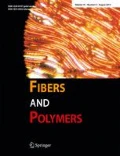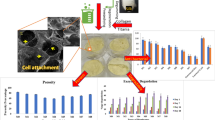Abstract
The use of silk protein as a biomaterial has been studied for decades. In this study, silk fibroin (SF)/hyaluronic acid (HA) blend scaffolds were prepared by freeze-drying technique. The structure and properties of the blend scaffolds were examined and analyzed. The results demonstrated that the secondary structures of the SF/HA scaffolds were mainly amorphous and β-sheet structures. The pore radius and porosity of the scaffolds decreased with a decrease in the freezing temperature decrease and an increase in the HA ratio. The pore radius and porosity were regulated from 32.22 μm to 290.76 μm and from 74.1 % to 91.15 %, respectively. In vitro, the SF/HA scaffolds could support the fibroblast cell adhesion and proliferation and showed good cytocompatibility. In vivo, the SF/HA scaffolds were implanted into the dorsum of Sprague Dawley rats to evaluate their bioactivity for dermal tissue reconstruction. The vascular-like structures appeared more rapidly in SF/HA scaffolds than that in the PVA group, and a new dermal layer was formed, as determined by histological analysis. The SF/HA porous scaffolds have promise as a dermal substitute.
Similar content being viewed by others
References
L. R. Sheridan and R. G. Tompkins, Burns, 25, 97 (1999).
M. H. Mohammadi, B. H. Araghi, V. Beydaghi, A. Geraili, F. Moradi, P. Jafari, M. Janmaleki, K. P. Valente, M. Akbari, and A. Sanati-Nezhad, Advanced Healthcare Materials, 5, 2459 (2016).
M. Loss, V. Wedler, W. Kunzi, C. Meuli-Simmen, and V. E. Meyer, Burns, 26, 644 (2000).
M. C. Robson, R. A. Barnett, I. O. Leitch, and P. G. Hayward, World J. Surg., 16, 87 (1992).
X. Li, R. You, Z. Luo, G. Chen, and M. Li, J. Mater. Chem. B, 4, 2903 (2016).
D. J. Wainwiright, Burns, 21, 243 (1995).
E. L. Heck, P. R. Bergstresser, and C. R. Baxtor, J. Trauma., 25, 106 (1985).
A. Srivastava, E. Z. DeSagun, L. J. Jennings, S. Sethi, A. Phuangsab, M. Hanumadass, H. M. Reyeset, and R. J. Walter, Ann. Surg., 233, 400 (2001).
S. Yan, Q. Zhang, J. Wang, Y. Liu, S. Lu, M. Li, and D. L. Kaplan, Acta Biomaterialia, 9, 6771 (2013).
D. P. Orgill, C. Butler, J. F. Regan, M. S. Barlow, I. V. Yannas, and C. C. Compton, Plast Reconstr. Surg., 102, 423 (1998).
L. Yan, J. M. Oliveira, A. L. Oliveira, and R. L. Reis, J. Tissue Eng. Regen Med., doi:10.1002/term.2226 (2016).
M. Lovett, C. Cannizzaro, L. Daheron, B. Messmer, G. Vunjak-Novakovic, and D. L. Kaplan, Biomaterials, 28, 5271 (2007).
Y. Yang, F. Ding, J. Wu, W. Hu, W. Liu, J. Liu, and X. Gu, Biomaterials, 28, 5526 (2007).
M. R. Sommer, J. R. Vetsch, J. Leemann, R. Müller, A. R. Studart, and S. Hofmann, J. Biomed Mater. Res. Part B: Appl. Biomater., doi: 10.1002/jbm.b.33737 (2016).
C. M. Li, C. Vepari, H. J. Jin, H. J. Kim, and D. L. Kaplan, Biomaterials, 27, 3115 (2006).
P. Shi, T. K. Teh, S. L. Toh, and J. C. Goh, Biomaterials, 34, 5947 (2013).
J. Jiang, C. Ai, Z. Zhan, P. Zhang, F. Wan, J. Chen, W. Hao, Y. Wang, J. Yao, Z. Shao, T. Chen, L. Zhou, and S. Chen, Artificial Organs, 40, 385 (2016).
T. W. Wang, J. S. Sun, H. C. Wu, Y. H. Tsuang, W. H. Wang, and F. H. Lin, Biomaterials, 27, 5689 (2006).
Y. Yu, Y. Wang, C. Lu, D. Long, Q. Zhang, S. Yan, R. You, and M. Li, Fiber. Polym., 17, 324 (2016).
W. Tao, M. Li, and R. Xie, Macromol. Mater. Eng., 290, 188 (2005).
M. Li, Z. Wu, C. Zhang, S. Lu, H. Yan, D. Huang, and H. Ye, J. Appl. Polym. Sci., 79, 2185 (2001).
Q. Zhang, Y. Zhao, S. Yan, Y. Yang, H. Zhao, M. Li, S. Lu, and D. L. Kaplan, Acta Biomater., 8, 2628 (2012).
F. Urciuolo, A. Garziano, G. Imparato, V. Panzetta, S. Fusco, C. Casale, and P. A. Netti, Biofabrication, 8, 015010 (2016).
S. Y. Venyaminov and N. N. Kalnin, Biopolymers, 30, 1243 (1990).
R. Gilli, M. Kacuráková, M. Mathlouthi, L. Navarini, and S. Paoletti, Carbohydr. Res., 263, 315 (1994).
Y. S. Chio, S. R. Hong, Y. M. Lee, and Y. S. Nam, Biomed. Mater. Res., 48, 631 (1999).
Author information
Authors and Affiliations
Corresponding author
Rights and permissions
About this article
Cite this article
Zhang, Q., Chen, S., You, R. et al. Silk fibroin/hyaluronic acid porous scaffold for dermal wound healing. Fibers Polym 18, 1056–1063 (2017). https://doi.org/10.1007/s12221-017-1230-6
Received:
Revised:
Accepted:
Published:
Issue Date:
DOI: https://doi.org/10.1007/s12221-017-1230-6




